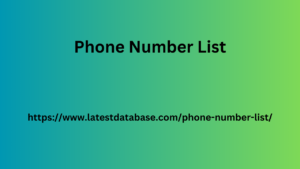Accessible document creation is essential to ensure that information is available to people with disabilities. By following specific guidelines, you can make your documents more inclusive and user-friendly.
Understanding Accessibility
Accessibility refers to the design of documents that can be easily understood and used by people with disabilities, such as blindness, deafness, or motor impairments. Inclusive design ensures that everyone has equal access to information.
Key Principles of Accessible Document Creation
- Structure: Use clear headings and subheadings to organize your content logically.
- Formatting: Employ appropriate fonts, colors, and contrast ratios to enhance readability.
- Alternative Text: Provide descriptive alternative text for images and other non-text elements.
- Tables: Use table headers and summary information Israel Phone Number to make tabular data accessible.
- Lists: Structure lists consistently using bullet points or numbered items.
- Hyperlinks: Use descriptive anchor text for hyperlinks to indicate their destination.
- Document Metadata: Include relevant metadata, such as title, author, and keywords, for search engine optimization.
Tools and Techniques
There are numerous tools and techniques available to assist in creating accessible documents.
- Screen Readers: These software applications can read aloud the content of documents, making them accessible to visually impaired individuals.
- Accessibility Checkers: Online tools and plugins can scan your documents for accessibility issues and provide recommendations for improvement.
- Authoring Tools: Many word processing and document creation software programs have built-in accessibility features.
- Style Guides: Following established style guides, such as WCAG (Web Content Accessibility Guidelines), can help ensure accessibility compliance.
Best Practices for Accessible Document Creation
- Plan Ahead: Consider accessibility from the beginning of the document creation process.
- Test with Users: Involve people with disabilities in testing your documents to identify and address any accessibility barriers.
- Stay Updated: Keep up with the latest accessibility standards and guidelines.
- Use Consistent Formatting: Maintain a consistent style throughout your document for better readability.
- Avoid Excessive Use of Formatting: Excessive PRESENT Artificial intelligence: the legal formatting can make documents difficult to understand.
- Provide Contextual Information: Include relevant context and background information to aid comprehension.
Examples of Accessible Documents
- PDFs: Use tagged PDFs with descriptive alternative text for images and tables.
- Word Documents: Utilize headings, styles, and alternative BW Lists text to create accessible Word documents.
- HTML Documents: Follow web accessibility standards, such as HTML5 and WCAG, to ensure accessibility.
Conclusion
Creating accessible documents is essential for promoting inclusivity and ensuring that information is available to everyone. By following the guidelines outlined in this guide, you can make your documents more user-friendly and accessible to people with disabilities.

